Buying Guide for Children’s Acoustic Guitars
Acoustic guitars are a popular choice as beginner instruments for children because people perceive them to be easier to play and cheaper than electric guitars.
Although an acoustic is generally less expensive than an electric (you don’t need to get an amp or a cable), it’s also a bit more difficult for children to play, especially when first starting. If you want your child to learn on an acoustic, you need to determine whether you want your child to learn on a steel string or a nylon string (classical).
Most teachers recommend that younger kids don’t start on a steel string since painful metal strings may turn them off from playing long-term. Even though many kids begin on nylon-stringed, there are lots of kids who are ready to progress from a nylon string to a steel string or who want to skip playing a nylon string altogether.
Best Acoustic Guitars for Kids Reviews
| Model | Picture | About | Review | Pricing |
|---|---|---|---|---|
| Yamaha FG JR1 | 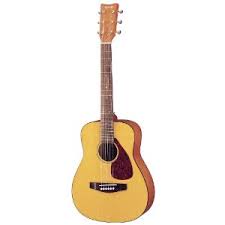 | A 3/4 sized excellent student guitar for kids ages 8 to 11. | Read the Full Review | Check Pricing on Amazon Check Pricing on Guitar Center |
| Yamaha FG JR2 | 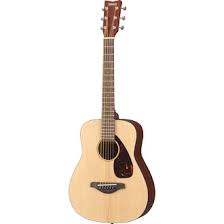 | A 3/4 sized very similiar to the FG1, but with slightly better wood. | Read the Full Review | Check Pricing on Amazon Check Pricing on Guitar Center |
| Baby Taylor | 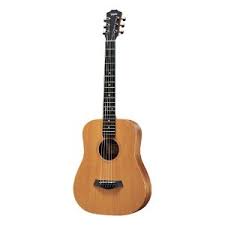 | High end 3/4 sized student guitar from Taylor Guitars. | Read the Full Review | Check Pricing on Amazon Check Pricing on Guitar Center |
| Jasmine S35 | 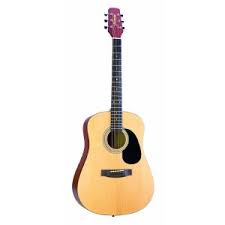 | Inexpensive full sized starter guitar for kids ages 12 plus. | Read the Full Review | Check Pricing on Amazon Check Pricing on Guitar Center |
| Luna Guitars Muse Safari | 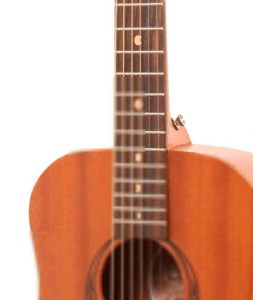 | Well reviewed mahogany top, travel guitar. | Check pricing on Guitar Center | |
| Rogue Starter | 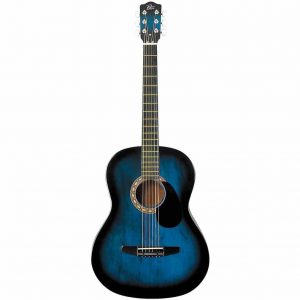 | Budget full sized beginner guitar for kids ages 12 and up. | Read the Full Review | Check Pricing on Amazon Check Pricing on Guitar Center |
Budget
As a parent who is looking for an instrument for your child to learn on, you most likely aren’t going to want to spend a lot of money on anything too high-end; luckily, the way that instruments are manufactured these days, you can get low to mid-range guitars that are great for kids to learn on.
A good price range for a beginner instrument is around the $100 to $150 mark. You can go much higher and get a high-quality instrument or go a bit lower and get something adequate for a beginner.
As with most things, you get what you pay for, so if you want a guitar that will last, sound good, and be easy to play, you will have to pay a bit more.
Read all of our acoustic reviews for kids.
Size
When shopping for a guitar for a child, you must get a make and model that is the right size. Otherwise, it will be awkward and uncomfortable to play. There are four basic sizes (with a few variations) 1/4 size, ½ size, ¾ size, and 4/4 (full) size.
- For a small child (ages 3 to 6), look for a 1/2 size or even a ukulele.
- For a medium-sized kid (ages 7 to 12), look for a 3/4 size.
- And for a big kid (13 and up) or an adult, a full-size is probably the best choice.
The best way to determine the proper guitar size for your child is to head down to your local music store and try out a few different sizes. To figure out the best fit, make sure your child’s right arm and shoulder can fit comfortably around the body, and the left hand should be able to reach the end of the neck.
If you are buying online and aren’t sure about the size of a particular model, you can check the scale length in the specs.
- 1/4 size guitars have a scale length of 19″
- 1/2 size has a scale length of 20.5″
- 3/4 size has a scale length of 22.75″
- 4/4 full size has a scale length of 24.75″ or 25.5
Tips on Choosing the Right Acoustic Guitar for your Child
Neck
The best instruments for kids tend to have thinner necks than standard guitars. It is essential to have a neck with a smaller width dimension so that kids can wrap their hands around it and play comfortably.
Tonewoods
Once you start shopping around, you will notice that different models are made of different woods. However, beginner guitars are generally made from the same types of wood.
The more expensive models, the rarer the wood is, for the most part. The wood choice affects the sound and tone. The top wood has the most significant impact on tone; spruce is a standard choice of top for most beginner guitars. Here are some of the types of tonewoods that you will come across.
- Ebony – Ebony is sturdy dark wood, often used as a fretboard material.
- Mahogany – Mahogany is a dense, hardwood, often used for sides and backs as well as in necks and bridges.
- Maple – Maple is common for sides and backs, especially on more affordable makes and models.
- Rosewood Is a very popular wood used on acoustic. It is used on most parts but is common on fretboards and bridges.
- Sapele – Sapele is similar to mahogany and is often used for sides and backs.
- Spruce –Spruce is a standard for acoustic tops.
Action
You may have come across reviews where a player is talking about the action of a guitar. It refers to how far the strings are from the fretboard. If an instrument has high action, then the strings are far away from the fretboard. If it has low action, it means that they are close to the fretboard.
For kids, you will want to look for a guitar that has low action, so it is easier to play. If you think the strings are too far from the fretboard, you can have this adjusted at a music shop, or you can do this yourself if you know how.
When it is too high, it isn’t easy to play, especially for kids. So if you are shopping in a store, try to find models with a low (strings are close to the fretboard), even action.
Intonation and Tuning
Intonation is the tone or pitch of your guitar as you move up the fretboard. If you have tuned your guitar and it still sounds like it is out of tune, then your guitar has poor intonation. You can fix this by adjusting the guitar or having it set up at a Music shop.
How well a guitar stays in tune is a significant consideration for anyone who is shopping for a new instrument, but it is especially important for beginners because it is incredibly frustrating to learn to play on something that is continually going out of tune.
All guitars go out of tune depending on all kinds of different things, but if you find one that won’t stay in tune or has a lot of reviews saying intonation is a problem, it is best to avoid it because it will be useless to play on.
Accessories
Gig Bag
If you want to help keep the instrument protected, you can get a gig bag or case. They are usually made of a nylon fabric with padding, you can also get hardshell cases, but nylon cases are a good option for beginners. It is handy to get a gig bag with a pocket to put picks and music sheets.
Picks
There are a few different types of picks available; Standard, Teardrop, Equilateral, Finger and Thumb, Shark Fin are a few types you may come across.
For a child, you can probably stick with a standard pick; they will use this to pluck or strum the guitar strings. When their skills develop, they can try out some other types of picks.
Strings
It is useful to have extra strings on hand in case any break or need changing. When changing a string on an acoustic, you should replace all of them at once, even if it has just one broken string.
Most strings are made from phosphor bronze with a thin plastic coating that protects the strings against the natural oils on a player’s fingers. If you are selecting your strings, you should know what gauge of string to get.
A string gauge is just a measurement of the thickness of a guitar string in thousandths of an inch. When describing gauges, guitarists generally leave out the decimal and only say the number. So a .010 is ten gauges. The larger the gauge, the heavier the string; for example, extra light strings would be 10 to 47s (.010 to .047), while heavy would be 14 to 59s (.014 to .059). For kids, you want to choose a lighter gauge like an 11 or 12.
Acoustic Tuners
Having a good tuner is pretty essential for beginners. It will help them keep their instrument in tune day to stay as well as help them retune if they have to change the strings.
There are a few different ways to tune a guitar. You can do it by ear or use an app. There are also lots of tuners you can buy that are made primarily to tune guitars.
Types of tuners include LED Tuners, Orchestral Tuners, Clip-On Tuners, Strobe Tuners which all have different functions and features.
What are the brands to get? Brands to avoid?
There are so many different types of brands to choose from; it is sometimes a little difficult to know where to start. You can buy pretty much any kind of guitar in any price range, but you will get what you pay for in most cases, so if you want an incredible-sounding instrument that is easy to play, you will need to pay a bit more for that.
I would avoid brands like First Act or Schoenhut that are generally available in toy stores. Instead, I would spend slightly more money and head over to a music store and look at a student model from Hohner, Jasmine, or Yamaha. These brands make guitars that are much better quality for the price than some of the toy store brands.
If you are shopping for a child who is taking lessons and you are looking for something that will last for many years, that has high quality and great sound. I would look at models from Fender, Epiphone, Huntington, Guild, Martin, or Taylor. The Baby Taylor and the Martin LXM Little Martin are excellent models to check out.
- Buying Guide for Children’s Acoustic Guitars - January 1, 2020
- The Best Guitars for Kids (Buying Guide) - May 23, 2018
- The Best Electric Guitars for Kids and Teens - May 14, 2018
